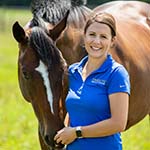The Basics of Fuel for Exercise in the Horse
There are several types of fuel the horse can use to sustain exercise, which can be broadly categorized as carbohydrates and fats. More specifically, carbohydrates for fuel are in the form of blood glucose or the stored version of glycogen. Glycogen is broken down into glucose when blood glucose runs low. Fat, for exercise, is in the form of free fatty acids in the blood or comes from the breakdown of fat stores in the body.
During aerobic exercise, the horse can use carbohydrates or fat for fuel. When working anaerobically, the horse can only use carbohydrates for fuel.
Factors that Influence the Availability of Fuel
The horse’s ability to access fuel for exercise depends on several factors, including:
- Diet
- Level of conditioning
- Phase of absorption after a meal
Horses who are adapted to a high fat diet, and conditioned appropriately, will be able to utilize more free fatty acids to fuel aerobic exercise, which will reserve blood glucose and glycogen stores for anaerobic work.
The ability to access fuel is also influenced by the phase the horse is in following the consumption of a concentrate, or horse feed, meal.
When a horse eats a concentrate meal, the sugars and starches are broken down to glucose and absorbed from the small intestine. To keep blood glucose within the correct range, the pancreas responds by releasing insulin. Insulin’s role is to send fuel to peripheral storage. When insulin is high post-meal, the ability to access fuel glycogen and fat for energy is impaired because the body is in storage mode. The hormone balance of the body is simply in opposition to supporting intense work following a meal.
When is the Best Time to Feed to Maximize Horse Performance?
Blood glucose and insulin peak two to three hours after a concentrate meal and return to baseline within four to five hours. Horse performance will be limited by the availability of stored fuel when insulin is high. During intense work, such as short anaerobic bursts or longer sessions of moderate intensity exercise, the horse won’t be able to mobilize stored glycogen or fat effectively.
During light intensity work, this is unlikely to cause any notable issues; however, horses that are asked to perform at a higher level should be worked at least four hours after they consume horse feed meals.
Feeding to Support Gastric Health During Exercise.
While feeding a concentrate meal before intense exercise would not be recommended, it is equally as important to ensure the horse has access to forage pre-exercise.
The horse’s stomach secretes acid continuously and when the stomach is empty, this acid will splash onto the unprotected, upper portion of the stomach during exercise. Acid contacting the upper portion of the stomach, the non-glandular region, is a significant cause of stomach ulcers in performance horses. Forage in the stomach will prevent the splashing of acid and also acts as a natural buffer.
For horses that don’t have 24/7 access to forage, their pre-ride snack can consist of any forage product; however, a long-stemmed forage, either hay or cubes, will be more effective than hay pellets. Adding Constant Comfort® to your horse’s pre-ride snack adds an extra level of stomach protection.
If you need help fine-tuning your horse’s feeding plan to support competitive goals, or have any other questions, please contact us for a free personalized equine feeding plan.

